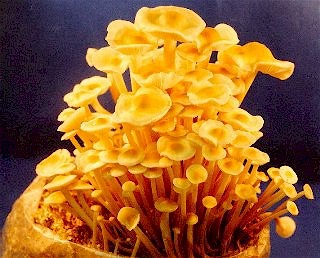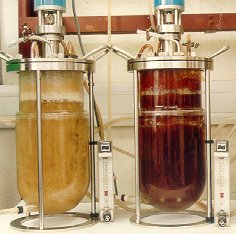 |
An Introduction to Fungi |
| The golden mushroom (Flammulina velutipes) grown using a home cultivation kit. |
Unlike bacteria, fungi are eukaryotes (i.e. their cells contain complex organelles such as nuclei which are also found in animal and plant cells). Although some fungi may superficially resemble plants recent molecular evidence suggests that fungi are probably more closely related to animals. Most fungi grow in the form of microscopic filaments called hyphae that extend and branch at their tips to form a vast network or mycelium. The familiar field and forest mushrooms are the fruiting structures that arise from such a network. To exploit new habitats fungi have to produce countless millions of spores since very few of these spores will successfully form new colonies. With gilled mushrooms the spores are produced on the surface of the gills. These delicate structures serve to increase the surface area available for the production of spores and are protected by the more robust cap. The presence or absence of a volva and ringare important characteristics used for identifying these types of fungi. Some species have pores, spines or blunt ridges instead of gills. However, the reproductive structures of many fungi do not have the characteristic mushroom shape at all and range in size from the giant puffball to the tiny conidiogenousstructures of moulds.
Classification of Fungi
The larger fungi are divided into two main groups (phyla) based on the way that they produce their spores. The Ascomycota produce their spores inside a long cell called an ascus. The Basidiomycota form their spores externally on a club-like cell called a basidium.
Role in nature
Fungi play a vital role in nature. Many are saprotrophs, living on dead organic matter such as leaf litter and have an important role in re-cycling. Others form symbiotic associations with trees and other plants (mycorrhizal fungi) which extend the plant root system assisting in the uptake of water and nutrients. Over 90% of plants have a fungus associated with their roots and many would not survive without their fungal partner. It has also been estimated that over 1000 species of insects and other creatures in the UK alone are dependent on fungi for food and shelter.
Applications of fungi
Some of the most important organisms used in biotechnology are fungi. Brewing and baking have been carried out for thousands of years and both are dependent on the conversion of sugar into alcohol and carbon dioxide by yeasts. In this century fungal fermentation has been harnessed to manufacture important therapeutic compounds, such as antibiotics and the cyclosporins used for preventing rejection of human organ transplants. Many enzymes are produced from fungi for use in the food, textile and other manufacturing industries. Indoor cultivation of edible mushrooms is a multi-billion dollar industry but so far limited to saprotrophic species.
 |  | |
| Fungi growing in laboratory scale bioreactors at BTTG. |
Number of species
In view of the importance of fungi it may be surprising to learn that it is not possible to say with any certainty how many species occur in a particular locality. Fungi differ from plants in that, with the exception of perennial species like some brackets, it is not possible to predict when or whether their fruiting structures will appear from year to year. They are also very easy to miss since most species produce fruit bodies that decay and disappear within a few days. The potential number of species that have to be considered when examining an unknown fungus does not help with identifications. For example, Pegler & Spooner (1992) estimate that there are more than 8,000 species of the larger fungi (i.e. fungi having fruit bodies large enough to pick and examine with the naked eye) in North America and Europe while Courtecuisse & Duhem (1995) describe 3,500 species in their field guide to the fungi of Britain and Europe. To put these figures in perspective consider the total number of birds or plants recorded in the UK given in the table below:
| Number of species recorded in the UK | Reference | |
| Birds | 552 (category A, B, C species) | British Ornithologists' Union |
| Mosses and Liverworts | 1034 (including varieties) | Mosses and Liverworts in Wales |
| Wild flowers | 2300 (approximate number) | The Wild Flower Page |
The lack of knowledge about local fungal populations needs to be addressed since many types of fungi, especially those that grow in association with trees, appear to be in decline. For example, in Germany’s Black Forest once common species, such as chanterelles, are now reported to be completely absent. Recent concern has been expressed about the effects of commercial collection of edible wild fungi on fungal populations but the real culprit is probably pollution (Rotheroe, 1998). Loss of habitat is also of increasing concern.
Recording fungi
Recording of fungi is largely carried out by amateur mycologists in the UK. Although non-professional, many are expert field mycologists and most belong to local fungus recording groups who collect all the records together and produce distribution maps for their area. A selection of dot distribution maps from the Common Fungi Survey carried out by the North West Fungus Group are available from a site maintained by John Edmondson, Curator of Botany at Liverpool Museum. At a national level records are collated by the British Mycological Society (BMS) and put on the BMS Foray Records Database.
A list of the most frequently recorded fungi in our region is available as a text file from John Taylor's site.
Endangered species
A provisional list of nationally endangered species and some notes on locally (Northwest England) rare species is available from Mike Walton's site.
Guidance on the collection of fungi
On 4 September 1998 English Nature published the first ever Wild Mushroom Pickers' Code of Conduct in the UK and it can be viewed on-line thanks to the British Mycological Society. You should read this document before collecting fungi for scientific study or for the pot.
Fungi are not plants.
Living things are organized for study into large, basic groups called kingdoms. Fungi were listed in the Plant Kingdom for many years. Then scientists learned that fungi show a closer relation to animals, but are unique and separate life forms. Now, Fungi are placed in their own Kingdom.
It is a hidden kingdom. The part of the fungus that we see is only the “fruit” of the organism. The living body of the fungus is a mycelium made out of a web of tiny filaments called hyphae. The mycelium is usually hidden in the soil, in wood, or another food source. A mycelium may fill a single ant, or cover many acres. The branching hyphae can add over a half mile (1 km) of total length to the mycelium each day. These webs live unseen until they develop mushrooms, puffballs, truffles, brackets, cups, “birds nests,” “corals” or other fruiting bodies. If the mycelium produces microscopic fruiting bodies, people may never notice the fungus.
Most fungi build their cell walls out of chitin. This is the same material as the hard outer shells of insects and other arthropods. Plants do not make chitin.
Fungi feed by absorbing nutrients from the organic material in which they live. Fungi do not have stomachs. They must digest their food before it can pass through the cell wall into the hyphae. Hyphae secrete acids and enzymes that break the surrounding organic material down into simple molecules they can easily absorb.
Fungi have evolved to use a lot of different items for food. Some are decomposers living on dead organic material like leaves. Some fungi cause diseases by using living organisms for food. These fungi infect plants, animals and even other fungi. Athlete’s foot and ringworm are two fungal diseases in humans. The mycorrhizal fungi live as partners with plants. They provide mineral nutrients to the plant in exchange for carbohydrates or other chemicals fungi cannot manufacture.You probably use fungal products every day without being aware of it. People eat mushrooms of all shapes, sizes and colors. Yeasts are used in making bread, wine, beer and solvents. Drugs made from fungi cure diseases and stop the rejection of transplanted hearts and other organs. Fungi are also grown in large vats to produce flavorings for cooking, vitamins and enzymes for removing stains.
GLOSSARY
- hyphae (hí - fee) plural: the threads that form the body of a fungus (mycelium)
- mycelium (my - sée - lee - um): see hyphae
- mycorrhiza (my - koh - rý - zuh) singular; mycorrhizae (my - koh - rý - zee) plural: a beneficial combination between a fungus and a living plant root
- symbiosis (sim - by - óh - sis) singular; symbioses (sim - by - óh - sees) plural: a partnership formed between two living organisms.
No comments:
Post a Comment